As the automobile became the preferred method of travel in the United States during the 20th century, car oriented development became the dominant pattern of city design. Today it is extremely difficult or simply impossible to go about ones daily life without some reliance upon an automobile. Furthermore, in most areas of the country, the lack of one makes a person a second class citizen. For a variety of reasons, there has been a resurgence in the interest for mass-transit oriented developments (TODs). Proponents of this alternative method of city organization argue for its superiority over car oriented developments in efficiency, aesthetics, and livability (to name a few).1 Although there is something to be said for all of these reasons, here I will concentrate on an argument for TODs from the perspective of social justice. Typically arguments from social justice have been among the more controversial because they often involved some sort of redistribution of resources; in American politics it is often unclear how much the rich should be forced to give up in order to help the poor. I hope to bypass this issue by looking at a current public policy that seems to have wide-spread public approval, the Americans with Disabilities Act, and derive from it an argument for government sanctioned support of TODs. In section 1, I describe a number of public policies, including zoning, highway, and accessibility standards for the disabled and from these derive the moral basis for the government support of TODs. In section 2, I explain my argument in detail and address a number of initial concerns. Finally, in section 3, I address the most plausible objection to widespread TOD development – that gentrification could cause the poor to lose their homes. Continue reading Social Justice and Transit Oriented Developments
Tag: new urbanism
The difference between trains and buses
Some people feel buses are the answer to all our mass transit needs. They will, of course, admit that big expensive commuter rail systems are more pleasant than a fleet of buses (anyone who has ridden on both can attest to this), but they will simply point to the price tag as the major issue at hand. How can we afford such large transit systems?
In fact, if you look at the issue from a certain perspective rail systems seem simply fascist. Whereas bus networks can be easily adapted to meet the ever changing demands of the customers (we must keep them happy!) , rail systems dictate what the customer behavior should be. It is very easy to change a bus route to accommodate a new population distribution (for example, the construction of a new subdivision); it is extremely difficult to change a rail system.
A rail system has the remarkable effect of change the area around it. Transit stops usually become hubs of development; property values go up around them and people try to move as close by as possible. In the Washington DC area, for example, real estate prices are largely a function of distance to a metro stop; people want to use the metro and thus want to be near a stop. But it is not clear how we should feel about this trend. On the one hand, a rail system can have an incredible stabilizing effect on a community. It supports clear neighborhood centers and a maximization of space (i.e. higher density) around the stops of the metro. This in turn greatly decreases the dependence of residents on cars and thus decreases energy consumption; if you live near a metro station/neighborhood center, you have all your basic needs met within walking distance and you can take the train to anywhere else you need to go.
However, the flip side of stability is restrictiveness. The rail will stay where it is for a great while and therefore people are forced to live where that system exists if they want the high quality mass transit that their tax dollars helped build. People must, in effect, react to what the government has provided and are not as free when choosing where to live. The government can, in effect, coerce people to live in a specified pattern. The ethical implications of all this are rather interesting, and when I have time I’ll post about my take on it. However, for now this is an issue about which I am still starting to form a view.
Why should we construct transit systems?
One common complaint raised about car-oriented transit is that it is fixated on ‘flow’. Conventional road projects are generally designed to move vehicles, with less concern for the local social dynamics affected by that flow. This means that a large (wide) road is deemed successful if it is able to keep traffic flowing at desirable speeds; when flow is king, the people outside the cars simply do not matter. There are many obvious reasons why this is bad for the community around such a road, but if flow is not the desired outcome of a transportation project then what is?
The question of what we want out of our transit systems gets far too little attention from those concerned about the politics of transit. Many people already ascribe to a view; they may think that flow is desirable (they don’t like to wait in traffic) or instead they might shake their fists at all the passing cars and think how all this flow is ruining their surroundings. But this typically degenerates into a battle between car owners and pedestrians, and these sort of battles rarely end in satisfactorily. It seems that when two large portions of our society are at odds about how to proceed, the only fair path is to rethink the premises that got us to such an impasse. The question I think we should be asking is why we want to build the transit system in the first place?
The simple answer to the above question just goes back to the idea of traffic flow; we want to build a transit system because we want to move people and things. But this doesn’t even seem like a step beyond the question for traffic flow; the fact that movement is important is assumed in the very idea of a transit system. The deeper question we want to ask is why we want to facilitate the movement of people and things; this challenges us to think about the sorts of things we value in life. Such a question also forces everyone to do a new calculation about the cost and benefits of various transit systems. At some point of efficiency, the transit system will destroy the very mode of living that we value; because it is not simply the movement that we value but something which that movement facilitates, it is possible for an increase in movement to lead to a decrease in quality of life. So, even though adding another lane to a road may increase flow (and thus be called an “improvement” in the eyes of the traffic engineers) it could actually harm everyone involved. At some point, being able to move across town a little faster is no longer worth it, especially if you have to destroy the town in the process.
The above is all very abstract, but it needs to be this way because I don’t know how much flow is worth in relation to quality of life. I suspect it isn’t worth much, but this should be an empirical question; we need to start thinking about how movement is necessary for a happy and fulfilling life.
Silver Spring – a pedestrian’s nightmare
Last week I visited the Washington DC area for the first time. I might have some more comments about my experience in the future but I want to start out with some comments about Silver Spring, MD. I will be living near downtown Silver Spring, so I wanted to get a feel for the area. In recent years, Silver Spring has undergone an urban revival of sorts. Before this time, the area was a typical (somewhat rundown) suburb of DC but a large amount of residential and commercial development along with its access to the DC subway system has made it a very walkable area on paper. There are a number of grocery stores, shops, cafes, restaurants (though most of these are of a chain variety), so that one doesn’t really need a car in order to live in this area. Again, on paper, this seems like a very happy place for a pedestrian.
However, when one gets down into the streets it becomes obvious that this city is still controlled by the car. Several wide and busy streets (highways really) bisect the downtown area bringing with them a ton of through traffic. At cross walks, this means that a pedestrian must wait for an extremely long time to cross most streets; preference is obviously given to traffic flow along these corridors. There also seems to be very little thought (or enforcement) of coherent and contiguous sidewalks. You will be walking along a sidewalk (The east side of Eastern Ave. in front of the Blair’s apartment complex comes to mind) and the sidewalk will simply end for no reason. I can’t for the life of me understand why this is acceptable. This trend gets even worse in other locations; there were many instances where a sidewalk only exists on one side of the street and the ‘sidewalked’ side will change as the street progresses. This means that one has to continually cross a typically busy road simply to walk down the street. In another instance a sidewalk would degenerate into a curbless extension of a small parking lot, so that there was nothing between pedestrians (squeezing next to parked cars) and traffic than a small line on the pavement. That sucks.
A trip to Middleton Hills – An example of new urbanism
Last weekend, Taryn and I went on a little bike ride in the country; it was quite nice. Rural Wisconsin is full of lovely….
Fields
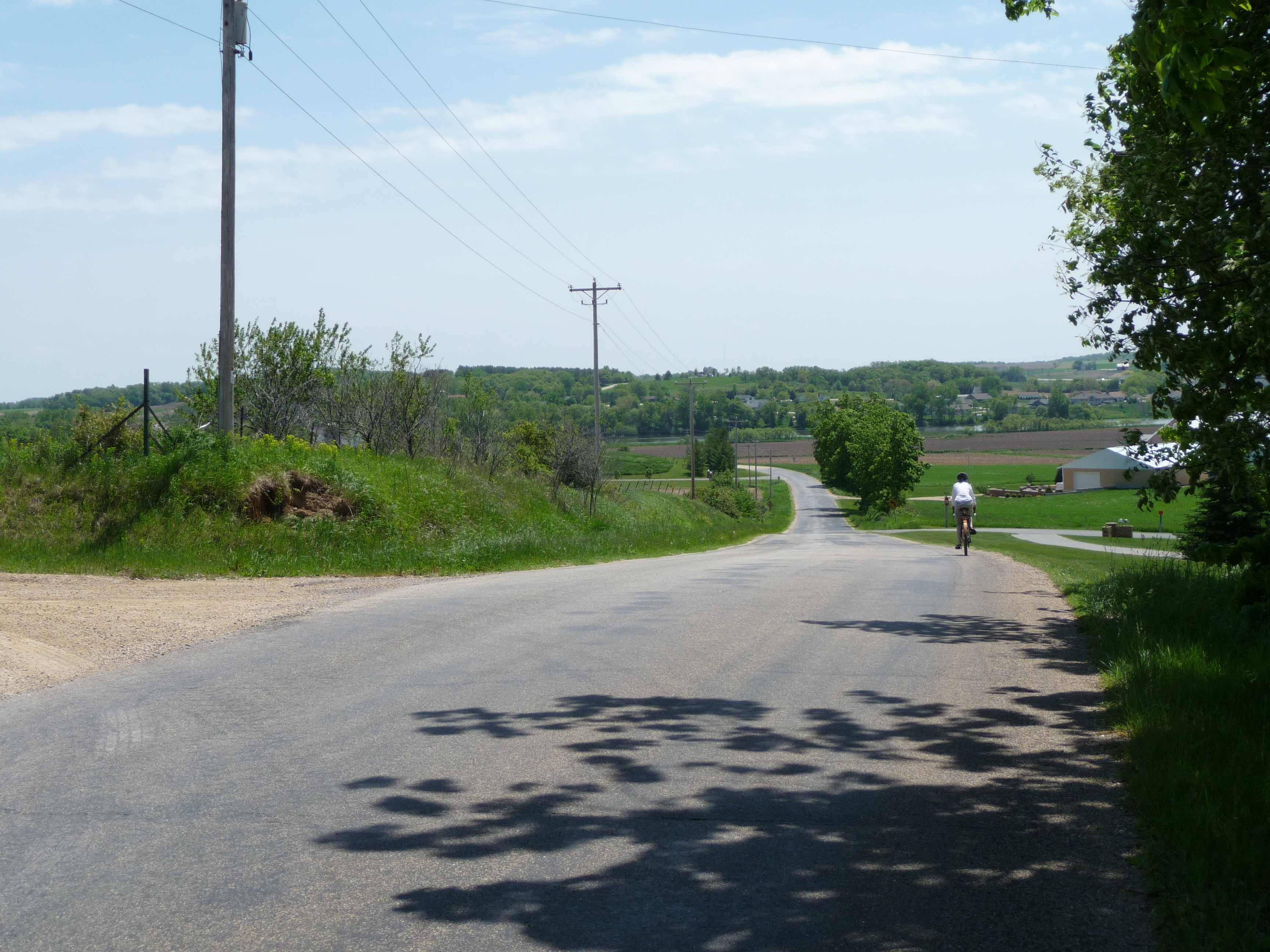
Winding Roads
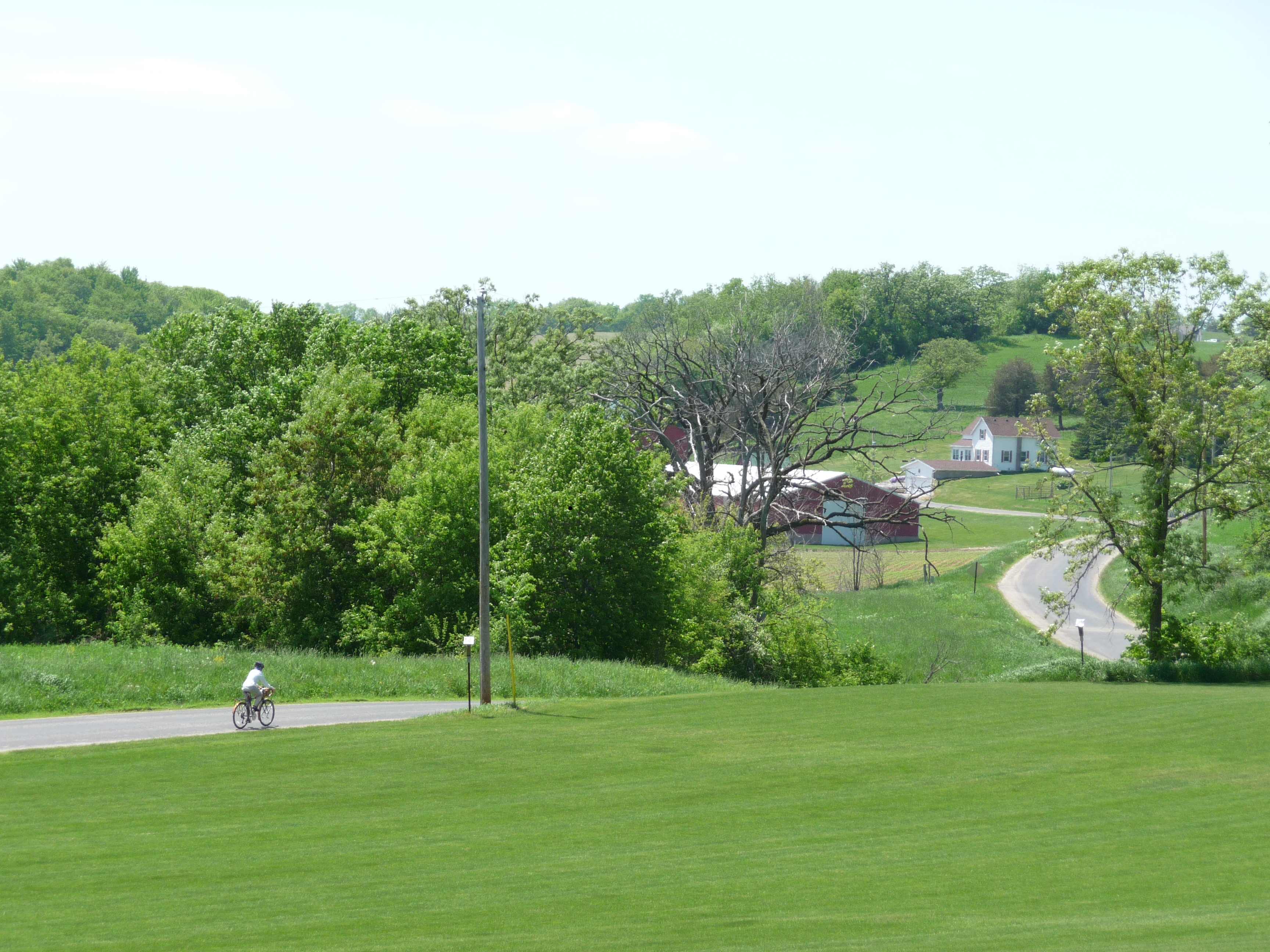
Cows
 and….Subdivisions!
and….Subdivisions!
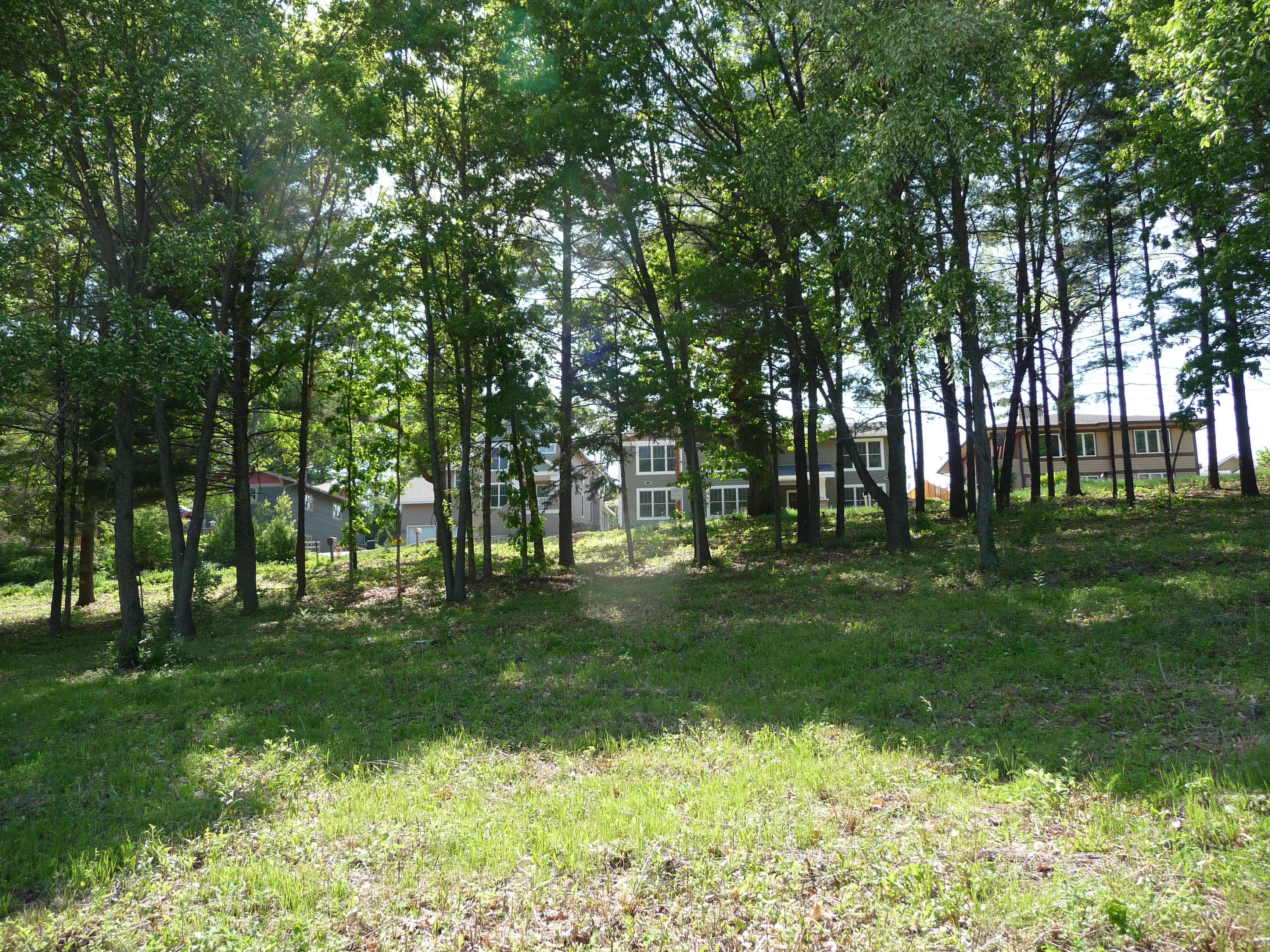
Ok, maybe that isn’t entirely fair; the cows really weren’t anywhere near the subdivision. But, you should still get the point. On the way back from our bike trip, we stopped by a subdivision in Middleton (a suburb of Madison) called Middleton Hills. The neighborhood has been lauded as the first example of new urbanism in Wisconsin. The concept of new urbanism isn’t exactly clear, but I take it to mean that it was constructed with a slightly higher density in order to facilitate a walking culture. This is supposed to not only decrease traffic, but also facilitate community development by bringing people into common spaces. I’m a fan of new urbanism, at least as it is theoretically laid out; however, I was curious whether that theory could be an effective guide to a real development in a very car oriented place like the Madison metro area.
Middleton Hills was designed by DPZ, headed by Andres Duany and Elizabeth Plater-Zyberk in 1993 and has since then slowly developed. There are two main aspects of the neighborhood to keep in mind. First, the design of the neighborhood is in a new urbanist style; this means that houses have small yards, relatively high density (for the suburbs) and a distinct community center (with stores). However, it is also a very regulated community; the dwellings are all designed in a certain style and every aspect of home and yard design is strictly regulated by a covenant (I recommend looking at the full covenant available at this site – its specificity is a bit startling). For instance, every home design must be approved by a board to guarantee that it will fit cohesively within the community. They prefer prairie style homes, so you will see an abundance of these in Middleton Hills. If you don’t know anything about new urbanism, I recommend looking at the wikipedia article. For now, I’m just going to start our journey through Middleton Hills…..
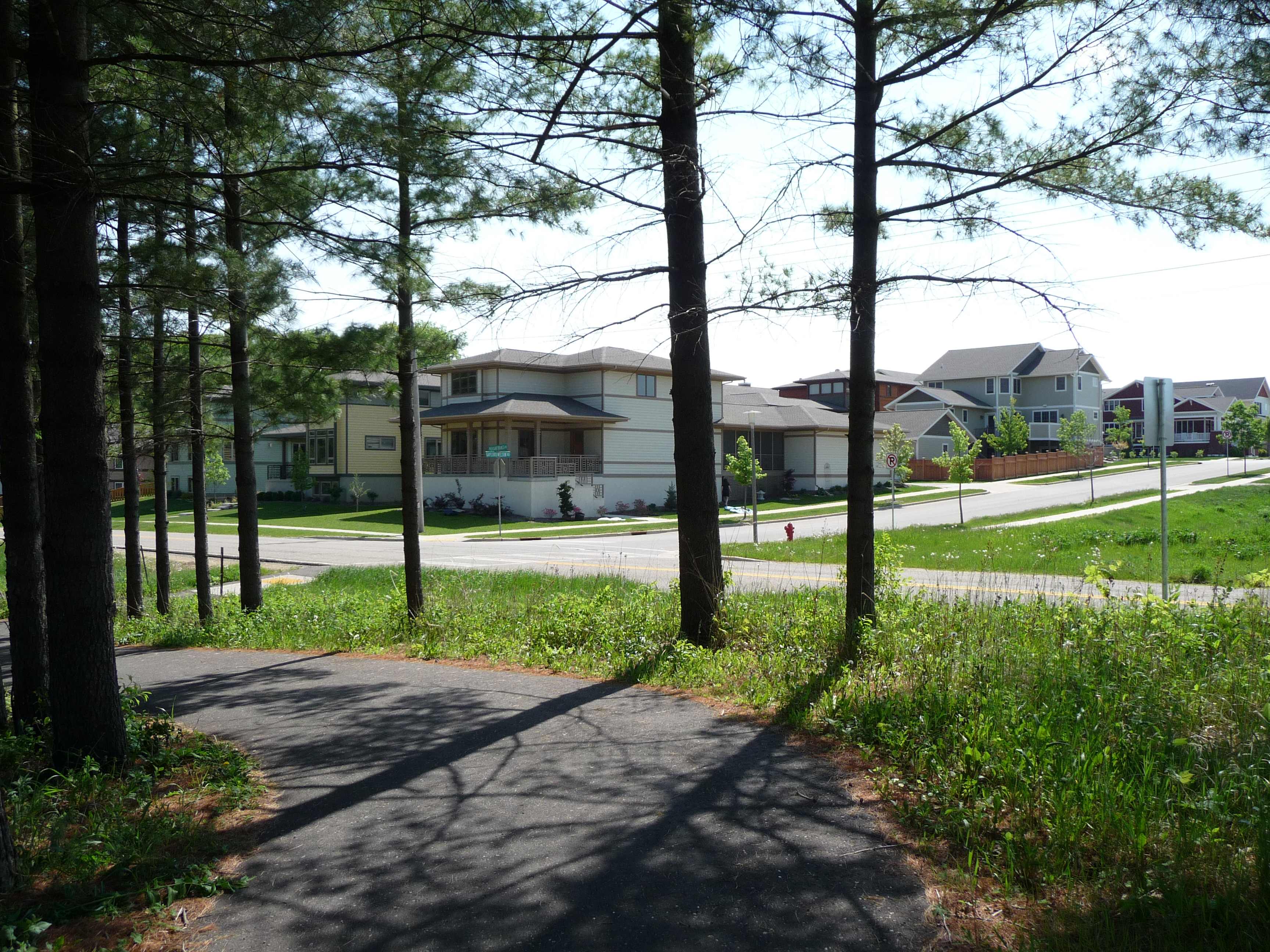 As one emerges from the nature preserve adjacent to Middlton Hills, you are treated to an interesting sight. This part of the Middleton Hills (the north-east side) is full of new and large prairie homes. That was what impressed me the most; these are very expensive homes, and that lends a certain air to the experience. It is yuppie, ordered, and clean (to the point of almost being sterile); how you respond to those three adjectives will likely determine how you will feel about Middleton Hills.
As one emerges from the nature preserve adjacent to Middlton Hills, you are treated to an interesting sight. This part of the Middleton Hills (the north-east side) is full of new and large prairie homes. That was what impressed me the most; these are very expensive homes, and that lends a certain air to the experience. It is yuppie, ordered, and clean (to the point of almost being sterile); how you respond to those three adjectives will likely determine how you will feel about Middleton Hills.
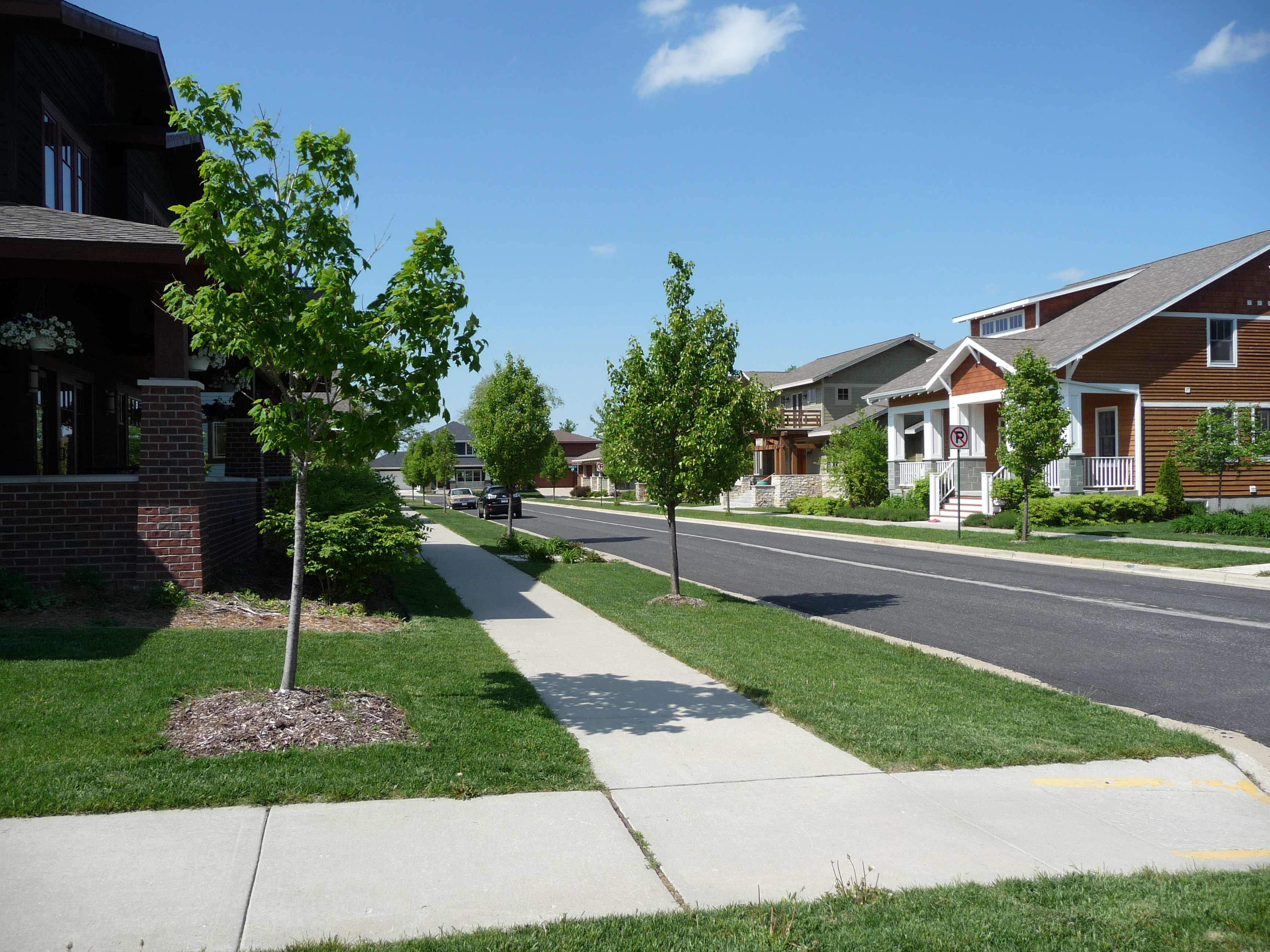 All of the lawns are perfectly manicured (more so than I have every really seen) and every house looks to be in perfect condition. The little trees and bushes seem to be carefully placed in a very deliberate way; and in fact, their placement is defined in the building plans. All of this has been approved by the community design board; I didn’t like it; neighborhoods with a great deal of complexity and nature make me feel like there is something alive there. Large, rich suburbs make me feel a bit uneasy;if I actually lived in such a place, I might start drinking a lot more. However, we should remember that this is far newer than many of the neighborhoods that might seem more friendly or natural. The complexity of old neighborhoods takes time, so perhaps Middleton Hills will become less sterile as it ages. However, I wonder if the extensive controls of buildings and landscaping would allow for this development. Only time will tell, I suppose.
All of the lawns are perfectly manicured (more so than I have every really seen) and every house looks to be in perfect condition. The little trees and bushes seem to be carefully placed in a very deliberate way; and in fact, their placement is defined in the building plans. All of this has been approved by the community design board; I didn’t like it; neighborhoods with a great deal of complexity and nature make me feel like there is something alive there. Large, rich suburbs make me feel a bit uneasy;if I actually lived in such a place, I might start drinking a lot more. However, we should remember that this is far newer than many of the neighborhoods that might seem more friendly or natural. The complexity of old neighborhoods takes time, so perhaps Middleton Hills will become less sterile as it ages. However, I wonder if the extensive controls of buildings and landscaping would allow for this development. Only time will tell, I suppose.
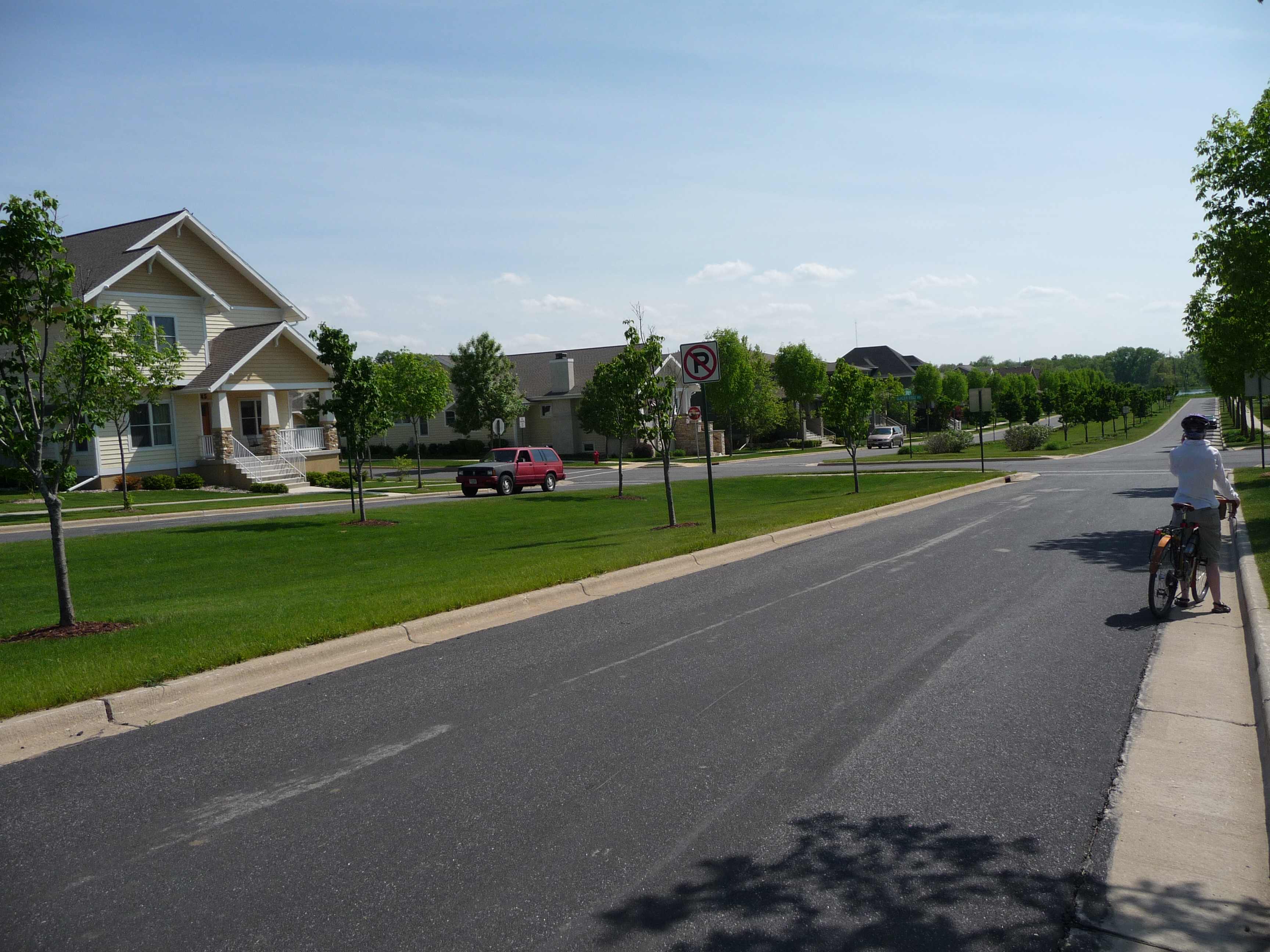 Above is the boulevard; perhaps when the trees grow up it will create a nice place to be but right now it just makes for a large expanse that is void of any life. It does function as an indication of the main road; it made it easy for us to find the path to the community center but didn’t do much else. One thing that started to bother me was the lack of people out and about; we had ridden through a good portion of the place without seeing a soul outside of their cars. This entire construction (higher density, with front porches very close to the sidewalk) is supposed to make more people walk around the community but on such a beautiful Sunday afternoon, the streets were vacant. That makes it seem like something is very wrong with the neighborhood.
Above is the boulevard; perhaps when the trees grow up it will create a nice place to be but right now it just makes for a large expanse that is void of any life. It does function as an indication of the main road; it made it easy for us to find the path to the community center but didn’t do much else. One thing that started to bother me was the lack of people out and about; we had ridden through a good portion of the place without seeing a soul outside of their cars. This entire construction (higher density, with front porches very close to the sidewalk) is supposed to make more people walk around the community but on such a beautiful Sunday afternoon, the streets were vacant. That makes it seem like something is very wrong with the neighborhood.
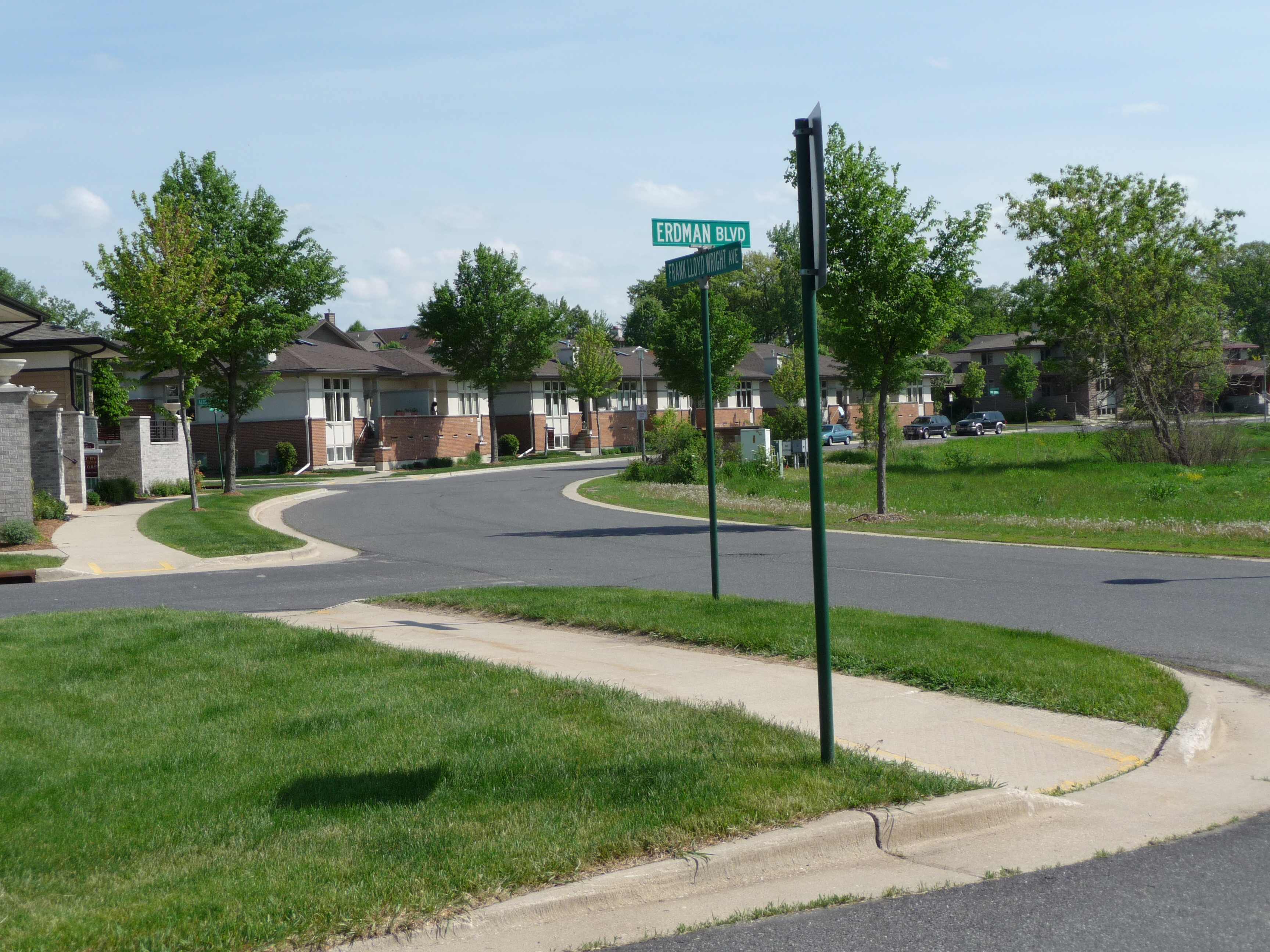 The closer one gets to the community center, the higher the density becomes. Here you see duplexes (I think); I actually think these are pretty attractive and I like the idea of increasing density in this way. However, these are extremely expensive. I recently found an ad for one of these condos on the Middleton Hills neighborhood association web site and it was posted for $374k. The problem is the type of condo this is; I’ll post the details below:
The closer one gets to the community center, the higher the density becomes. Here you see duplexes (I think); I actually think these are pretty attractive and I like the idea of increasing density in this way. However, these are extremely expensive. I recently found an ad for one of these condos on the Middleton Hills neighborhood association web site and it was posted for $374k. The problem is the type of condo this is; I’ll post the details below:
6874 Frank Lloyd Wright Ave
3 Bedrooms
2 Bath
2700 Sq.Ft.
$374,936.00Impeccably maintained Middleton Hills condo overlooking pond. Beautiful sunsets right outside the front door! Built 7 years ago, it still looks brand new! Gourmet kitchen w/cherry cabinets, stainless appliances, solid surface counters. Open floor plan w/2 sided fireplace, maple floors, trim & doors, & attached screen porch. Spacious master w/whirlpool & ample closets throughout. Tons of additional storage. 3rd bedroom needs stairs for legal egress. Square footage taken from Middleton Assessor. Owner is licensed realtor. Open Sundays 1-3.
So, the homes and condos being sold in Middleton Hills are for the rich. This is strange to me because this land should be cheap; one should be able to get a very affordable home all the way out in Middleton. However the prices for condos in this neighborhood rival those in downtown Madison, simply because they are constructed in a luxurious way. One should remember that a central tenant of new urbanism is the need to build complete communities; you need to have places to live for both the person who owns the community store and the person who works behind the counter.
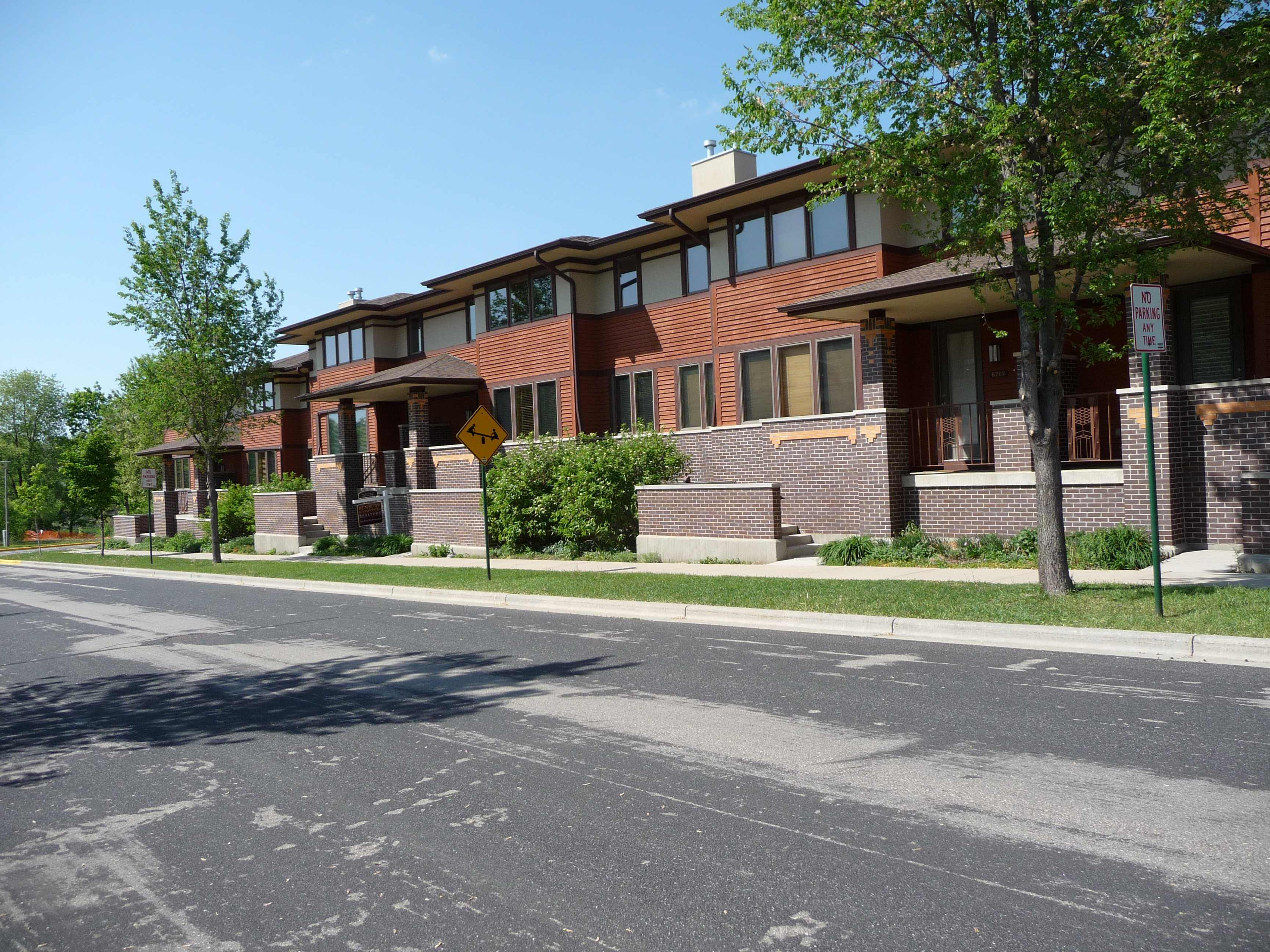
This was the highest density area that I could find in the Middleton Hills development; they look to be more condos, and I am sure they are beautiful and expensive. I think this absence of modest housing is a huge problem for the community; in a sense it means that this subdivision is not a community at all. I will get to the “community center” in a moment, but I can preemt this by observing that most of those living here must drive to work every day. The same goes for those working in the businesses nearby; the prices keep those who work at the nearby grocery store or coffee shop from actully living near their workplace. The location is also poorly integrated with the mass transit system of the Madison metro area; this means that Middleton Hills is just as car centric as any other suburban area. And this reliance on the car is one of the things new urbanism is meant to remedy.
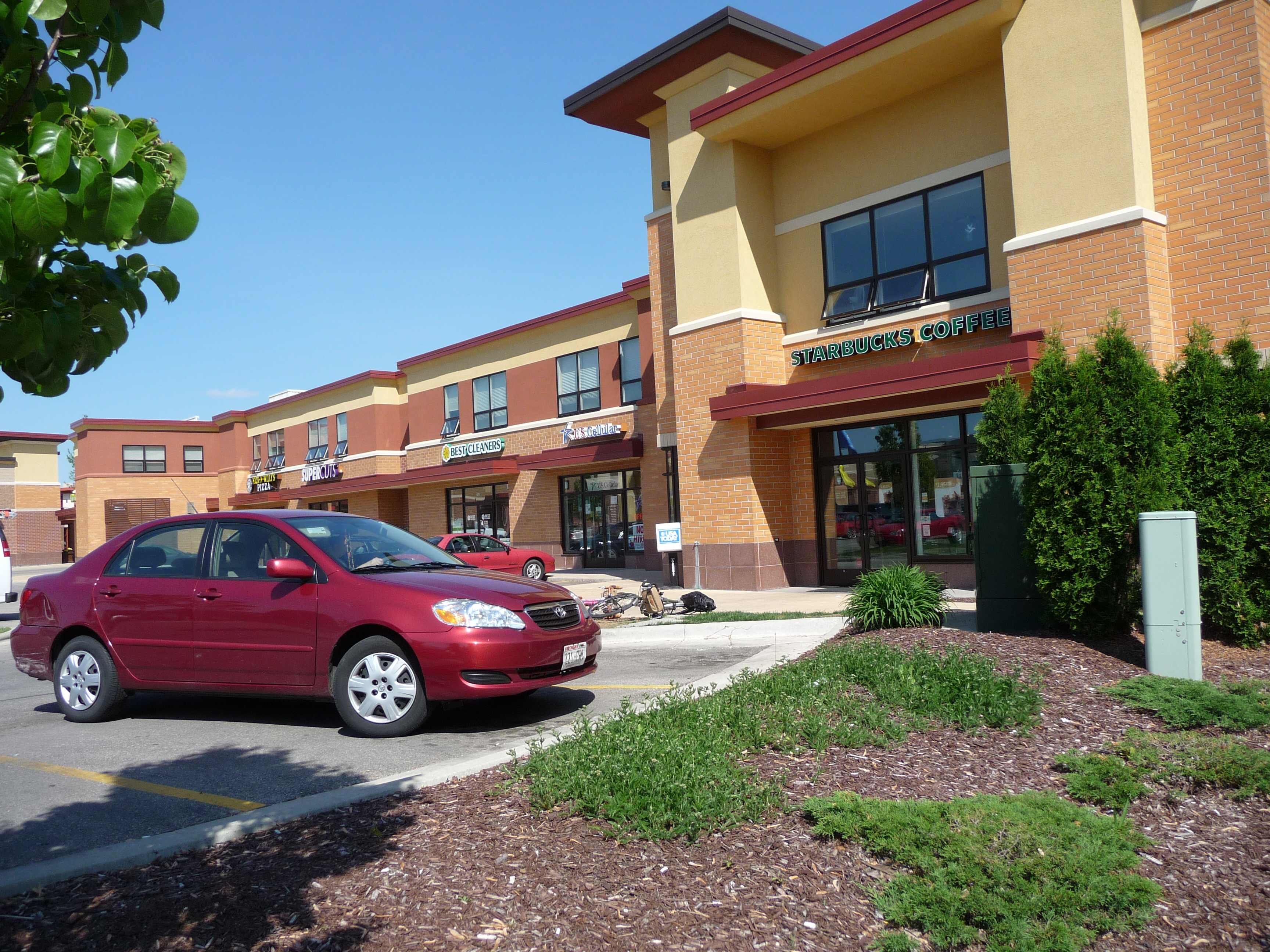 Here is the “community center”; the supermarket is off to the left (outside of the picture); it is a prairie style strip mall, I suppose. The idea of having a shopping center close to ones home is that you might walk there. I got the impression that most people took their car, even if they were just going to get a cup of coffee (and remember this was a near perfect day to be outside).
Here is the “community center”; the supermarket is off to the left (outside of the picture); it is a prairie style strip mall, I suppose. The idea of having a shopping center close to ones home is that you might walk there. I got the impression that most people took their car, even if they were just going to get a cup of coffee (and remember this was a near perfect day to be outside).
So, that is the end of the little tour. I think Middlton Hills fails pretty miserably at being a good example of a well functioning community. I suppose the architecture is more interesting than most subdivisions, but it lacks the same life that true urbanism provides. I would be very intersted to see these principles developed in a part of town closer to where people work (and with better mass transit connections); but the current example, located so far from the necesities of life, is almost destined to fail. In the end Middleton Hills felt almost like a caricature of new urbanism, rather than the real deal. I’ll certainly return to this visit in some later posts; right now I have to go do something useful for a change.
Something about Ecocities
I’ve just finished reading a book about ecological city building by Richard Register. In Ecocities, Register proposes that the current methods of city planning, which advocate single use zoning and great distances, are horribly inadequate. The cities most of us live in are zoned such that people live far from where they work and shop; each human activity has its own area in the modern city; this makes car travel the most practical method. There are of course some exceptions (if one lives in Manhattan, for example, it would be quite easy to never leave the island) but for the most part, this is an accurate model of the suburban city.
It doesn’t take too much effort to realize the problem with the single use zoning. It is tremendously inefficient. Most people travel with their car every day to and from work; they are not using the space that the automobile provides; in order to simply move themselves, they have to bring along something that weighs a ton or so. Why do we agree to live with such an arrangement? Well, suburbs promise to be pleasant, for one; after all, cities can be rather stressful places to live. And it seems like a good idea to have a plot of land to oneself (though it seems like this land is so often wasted by planting huge tracts of grass….). Compound this with the abundance of cheap energy in the form petroleum and you get the current trend for civilization to sprawl over all the landscape. Driving to far off places is cheaper than buying land in the polluted and noisy city, so it is hard to see an argument against such a sprawl.
Register seems to think that the main problem with our current arrangement is the way it ruins lives, both animal and human. It devastates ecosystems as well as creates a dangerous and violent environment in which heavy objects (automobiles) whizz through the air at great speeds. People also become emotionally separated from each other because of their great physical distances from one another. I think these are all good reasons for hating cars (though I’m not sure the last one is so true, given how much New Yorkers despise each other) but the most pressing concern originating from the petroleum induced sprawl is the imminence of ‘peak-oil’ .
Reaching ‘peak-oil’ means that we have reached the point where petroleum production will begin to decline. This is built into the concept of a finite resource like fossil fuels; we will someday run out. This is why they are not sustainable sources of energy. Fossil fuels are truly amazing in most respects. In case you haven’t stopped and thought about it, try to imagine how much it would cost you to have your car towed across town by a team of animals. Beasts of burden are very expensive to feed and take care of, but this could be accomplished for a few dollars using an internal combustion engine. With this in mind, it isn’t a stretch to consider the cultural and technological boom of the 20th century to be a result of petroleum. And now imagine the disaster that could ensue if it is used up.
In my opinion, Register’s most important point (one that is also expressed by other people concerned about peak-oil) is that we must re-structure our cities in order to survive after oil is gone. It will no longer be economical to drive to work if you live 30 miles away; therefore we need to build communities that are ‘walkable’, in which you could walk to work, to the store, and home again. He also would like to see extensive use of bicycles in his ‘ecocities’ but they should not be the primary method of transportation. He advocates a major movement of people from the suburbs and non-productive rural areas (places not involved in agriculture) to inside the city. This would cause the density of cities to increase dramatically, though he wishes to mitigate this problem by ensuring that architecture produces cities in which people would want to live. This includes numerous natural spaces and gardens that would also have the effect of increasing biodiversity. To get an idea of what this would entail, I calculated the density that would result from the current population of Madison moving into an area similar to (though quite a bit larger than) Register’s vision of an ecocity; I found that the density would be about 12,000 people /square mile. This is similar to the density of a city like Chicago.
Whether the sort of population density envisioned by Register would be desired by people is not clear. He seems to portray this arrangement as some sort of Utopia; I have my doubts as to whether people are capable of creating such places (there certainly are few examples in history of society working this well). However, I do not doubt that a radical increase in density will be required given the coming scarcity of transportation fuels. I don’t think it is likely that we will be able to completely replace our current levels of fossil fuel energy with sustainable sources, and therefore, a radical reduction in energy consumption is almost certainly necessary. But how do we accomplish this without displacing large populations who will be short of food and other resources? I’m not sure that we can shove density down the throats of citizens who are, for the moment, enjoying very cheap energy. Hopefully, people will slowly come to realize the unsustainable nature of suburban living and migrate to communities that have all the necessities of life within a reasonable distances. If this does not happen, and there is a sudden oil ‘crash,’ then it might be best to obtain a nice piece of land and a whole lot of guns; because if large groups of people are not prepared for the sudden drop of energy availability, and must fight to survive, things could get quite ugly. This is clearly what Register hopes to avoid.
I have many other thoughts about this topic, but hopefully this serves as an adequate introduction. There are other voices in this debate, including the more moderate ‘New Urbanists‘ who have been far more successful than Register. I’ll certainly see what they have to say as well.